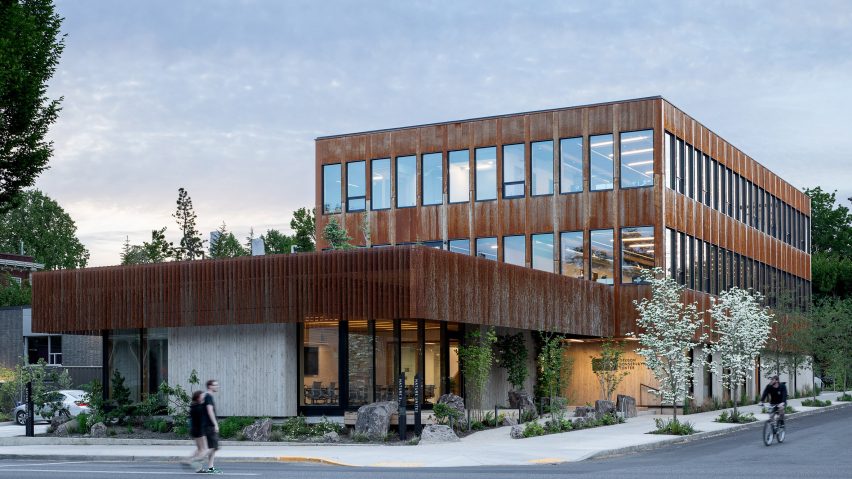Weathered steel and juniper siding clad the cross-laminated timber community centre that Lever Architecture has added to the Oregon outpost of The Nature Conservancy.
The local firm added a one-storey volume made of cross-laminated timber (CLT) to a three-story building that was completed in the 1970s on a corner plot in Portland's Buckman neighbourhood.
The project forms the Oregon offices of The Nature Conservancy, a non-profit organisation founded in 1951 to conserve lands and waterways around the world. It has offices in almost every US state and is headquartered in Virginia.
The cross-laminated timber (CLT) panels, which comprise layers of lumber glued together, are made from Douglas fir from the region. The panels were also manufactured in Oregon. Lever Architecture claims the extension is of the first to be made with CLT produced in the US.
"The addition is one of the first in the US built with domestically-fabricated CLT panels that are certified by the Forest Stewardship Council (FSC)," the studio said.
In addition to the panels that use local materials, other aspects also make the most of Oregon's natural materials. Juniper siding on the exterior was sourced from The Nature Conservancy's conservation site in Eastern Oregon, Juniper Hill preserve.
Cedar boards sourced from trees in the coastal Willapa Bay reserve are used on the green roof of the extension. Lever Architecture also chose native plants for the rooftop including bushes and wildflowers from the state's Rowena Plateau.
"To create an expression of The Nature Conservancy's work in Oregon and to connect staff and visitors to nature, the design integrates materials and plantings specific to their priority projects around the state," the studio said.
Cedar and hemlock trees are planted at another part of the property. At the entrance are plants from Oregon's Cascade-Siskiyou National Monument, which encompasses 114,000 acres (46,134 hectares) of mountains.
Weathering steel wraps around the original building and the addition is to visually tie the project together.
Inside, all of the rooms were renovated to become light-filled spaces. The community centre offers a variety of spaces for working, holding meetings and hosting events. The ground floor contains a conference room, while the two floors above have smaller work areas. A staff cafe and lounge round out the 15,000-square-foot (1,393-square-metre) project.
Lever Architecture said that sustainability formed a key part of the project, which has achieved a LEED Gold certification – the highest score for a building's energy efficiency
In addition to choosing to keep the original office building, CLT was used because it has a lower embodied carbon footprint than concrete or steel, as shown in a recent report by the University of Washington.
Other US projects built with CLT are a Connecticut high school by Gray Organschi, a building at the University of Massachusetts Amherst and an Atlanta house by Jennifer Bonner.
Efforts to improve the energy efficiency of The Nature Conservancy's Oregon office also include introducing solar panels on the roof and a subsurface filtration system that manages stormwater on-site.
Photovoltaics produce 25 per cent of the office building's electrical supply, while systems and fixtures were replaced to reduce water consumption by 44 per cent and electric consumption by 54 per cent.
Lever Architecture has also designed a factory building in Portland with weathering steel and built a tasting room for a winery in Oregon's Yamhill County. The firm has also proposed a 12-storey tower for Portland which would be the US's first high-rise wooden structure.
Photography is by Jeremy Bittermann unless otherwise stated.

